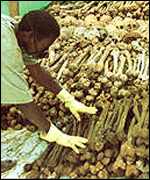|
Up to a million people died before the RPF (some of whose personnel are Hutu) was able to take full control. Unlike the instigators of the killings of Armenians in 1915, and of Jews and Roma in 1941-5, no-one tried to keep the genocide in Rwanda a secret. Journalists and television cameras reported what they saw, or what they found when the genocide was over. There was even a UN force (UNAMIR) in place, monitoring the ceasefire and now obliged to watch as people were killed in the street by grenades, guns and machetes. ('We have no mandate to intervene.' UNAMIR did their best to protect trapped foreigners, until they were pulled out of Rwanda altogether.) But the genocide organisers were conscious of the risks of international scrutiny: over the radio the killers were constantly incited to continue, but 'No more corpses on the roads, please'. Corpses in the countryside were covered with banana leaves to screen them from aerial photography.
Although on a large scale, this genocide was carried out entirely by hand, often using machetes and clubs. The men who'd been trained to massacre were members of civilian death squads, the Interahamwe ('those who fight together'). Transport and fuel supplies were laid on for the Interahamwe - even remote areas were catered for. Where the killers encountered opposition, the Army backed them up with manpower and weapons. The State provided Hutu Power's supporting organisation; politicians, officials, intellectuals and professional soldiers deliberately incited (and where necessary bribed) the killers to do their work.
Local officials assisted in rounding up victims and making suitable places available for their slaughter. Tutsi men, women, children and babies were killed in thousands in schools. They were also killed in churches: some clergy colluded in the crime. The victims, in their last moments alive, were also faced by another appalling fact: their cold-blooded killers were people they knew - neighbours, work-mates, former friends, sometimes even relatives through marriage. Even aid agencies were helpless; having let into compound or hospital people injured or in flight, they were forced to leave them there. Few survived.
Cold blood, with a shot of motivating fear, was what the planners wanted: the Interahamwe weren't fuelled by drink, drugs or mindless violence, but by fanatic dedication to a political cause. There were indeed people stoked-up on drink or hysteria or a manic wish to show they were 'on the right side' ; but when these mavericks began to join in and kill on whim, local administrators called for police assistance: such 'disorderly elements' might derail the genocide programme.
The definition of 'genocide' was an international sticking-point. There'd been at least 10 clear warnings to the UN of the 'Hutu power' action, including an anxious telegram from the UNAMIR commander to the then UN Secretary- General (Boutros Boutros Ghali) three months before the event. The UN Security Council met in secret after the start of the violence. At this meeting Britain urged that UNAMIR should pull out (and later blocked an American proposal to send in a fact-finding mission when the death toll had reached six figures). Council members resisted admitting 'that the mass murder being pursued in front of the global media was in fact genocide': genocide involved action no-one wanted to take. Once it was inescapably clear that genocide was indeed going on, it was too late. (The USA had actually banned its officials from using the term. Finally, in June, Secretary of State Warren Christopher grumpily conceded 'If there's any particular magic in calling it genocide, I've no hesitancy in saying that'.)
The USA, asked to send 50 armoured personnel carriers to help UNAMIR save what and whom it could before its departure, marked time and then sent the APCs to Uganda. Asked to use its hi-tech skills to get the génocidaire radio off the air, America replied, 'the traditional US commitment to free speech cannot be reconciled with such a measure', on this occasion. France, a backer of most French-speaking African governments, had been backing the genocidal government: it was one of their generals who advised the Hutus to 'improve their image' (hence, perhaps, the order to keep corpses out of the sight of cameras).
|
|
.
Bones of massacred Tutsis
|

